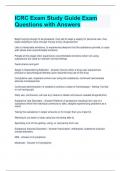ICRC Exam Study Guide Exam
Questions with Answers
Begin buying enough to be prepared, may sell to keep a supply for personal use, may
begin stealing to have enough money to buy drugs/alcohol
Use to manipulate emotions, to experience pleasure that the substance provide, to cope
with stress and uncomfortable emotions
People at this stage often experience uncomfortable emotions when not using,
substances are used to maintain normal feelings
Feels shame and guilt
Stage 3: Dependency/Addiction - Answer-Occurs when a drug user experiences
physical or psychological distress upon discontinuing use of the drug
Compulsive use, impaired control over using the substance, continued use besides
adverse consequences
Continued administration is needed to achieve a state of homeostasis - feeling "normal:
or not having pain
Daily use, continuous, will use any means to obtain and secure needed drugs/alcohol
Substance Use Disorders - Answer-Patterns of symptoms resulting from use of a
substance which the individual continues to take, despite experiencing problems as a
result
Taking the substance in larger amounts or for longer than you meant to
Wanting to cut down or stop using but not being able to
Spending a lot of tine getting, using, or recovering from use
Substance Induced Disorders - Answer-Intoxication, withdrawal, substance induced
mental disorders,
Mild - Answer-2-3 symptoms
Moderate - Answer-4-5 symptoms
,Severe - Answer-6 or more symptoms
Five Critical Components of Effective Treatment - Answer-1) Assessment
2) Patient-Treatment Matching
3) Comprehensive Services
4) Relapse Prevention
5) Accountability
The Nervous System - Answer-The brain, the spinal cord, the peripheral nerves
Central - brain and the spinal cord, psychoactive drugs primarily affect the CNS
Peripheral - all the nerves that branch out
Divisions of the Peripheral Nervous System - Answer-1) The Sympathetic Division -
prepare the body for activities which expend energy
2) The Parasympathetic Division - aids the body in returning to normal after a period of
expending energy
Where do psychoactive drugs have their effect? - Answer-The synaptic cleft
Depressant drugs thicken the medium in the synaptic cleft used for transmission,
therefore, slowing down transmission
Stimulant drugs tend to thin this
Acetylcholine - Answer-an excitatory neurotransmitter released by axons
Norepinephrine - Answer-Associated with arousal reactions
Dopamine - Answer-Associated with body movement and pleasure
Serotonin - Answer-Associated with regulation of sensory perception, sleep and body
temperature
Alcohol - Answer-CNS Depressant - Most abused drug in our society
This is the only drug where a large number of those who use it do not become
physically dependent on it
Sedative-Hypnotic - Answer-Substances that induce depression on the CNS
3 Categories:
, 1) Barbiturates - used to treat anxiety, induce sleep, and control seizures (reduce
tension and anxiety, relax) - barbiturates have slowly been replaced with safer
benzodiazepines
2) Minor Tranquilizers - depressant drugs used to treat anxiety and insomnia (basically
benzodiazepines)
3) Other Sedatives-hypnotic: "catch-all" category for sedatives/hypnotics
Narcotics/Opiates - Answer-Cause sedation and euphoria by causing depression of the
CNS
Relieve pain, suppress cough, and control diarrhea
Physical and psychological dependence
Inhalants - Answer-CNS Depressants
Creates an effect similar to alcohol intoxication, excitability. and delirium
Physical and psychological dependence
Cleaners, cosmetics, paint solvents, glues, motor fuels
Marijuana - Answer-The most frequently use illicit drug in the U.S.
Depressant, stimulant, some analgesic, and some hallucinogenic effects
Physical and psychological dependency potential
Hallucinogens/Psychedelics - Answer-Alter mood, thought, and perception.
Cause CNS depression and stimulation
Creates psychological but NOT physical dependence
Most hallucinogens are naturally occurring compounds (plants)
Individual experiences a heightened awareness of sensory input, experiences vivid but
unreal imagery
Screening - Answer-Process by which a client is determined appropriate and eligible for
admission into a particular program. Criteria may include age, sex, place of residence,
legal status, veteran status, income level, and/or referral source
Evaluate the psychological, social, and physiological signs and symptoms. Identify any
coexisting conditions




